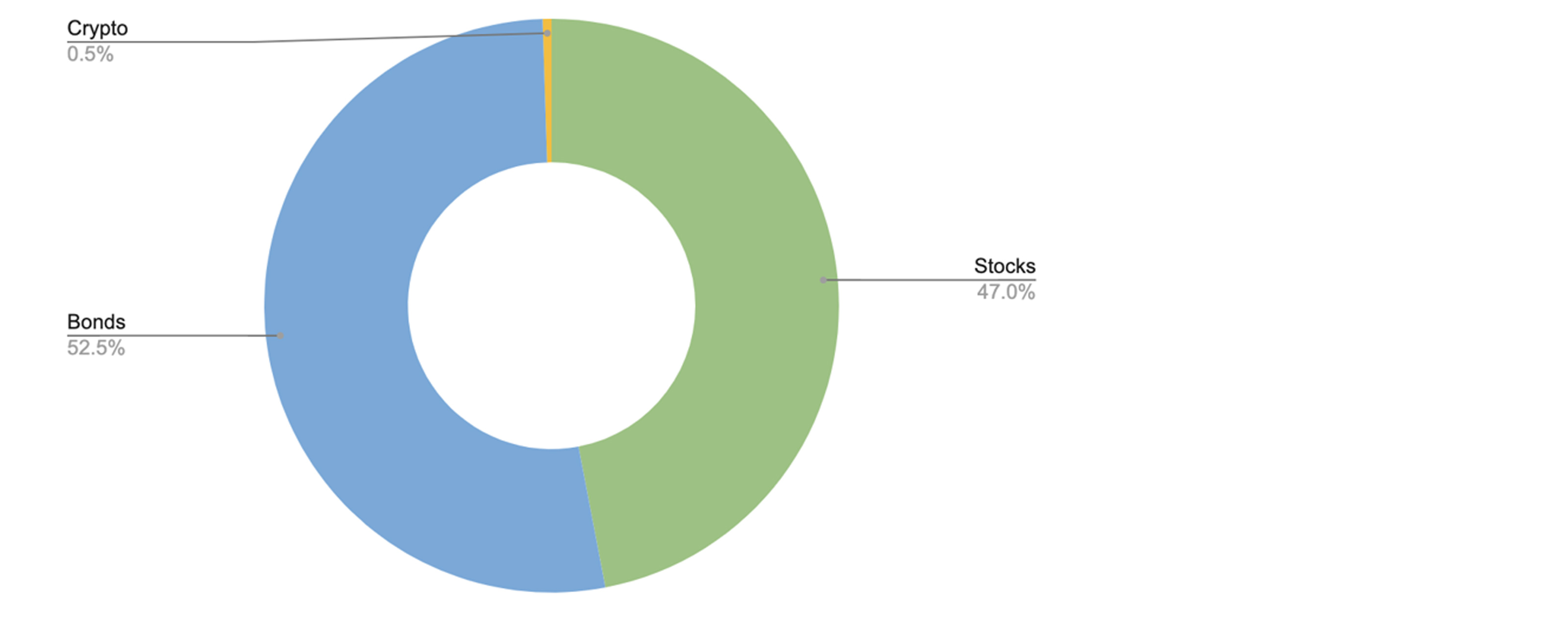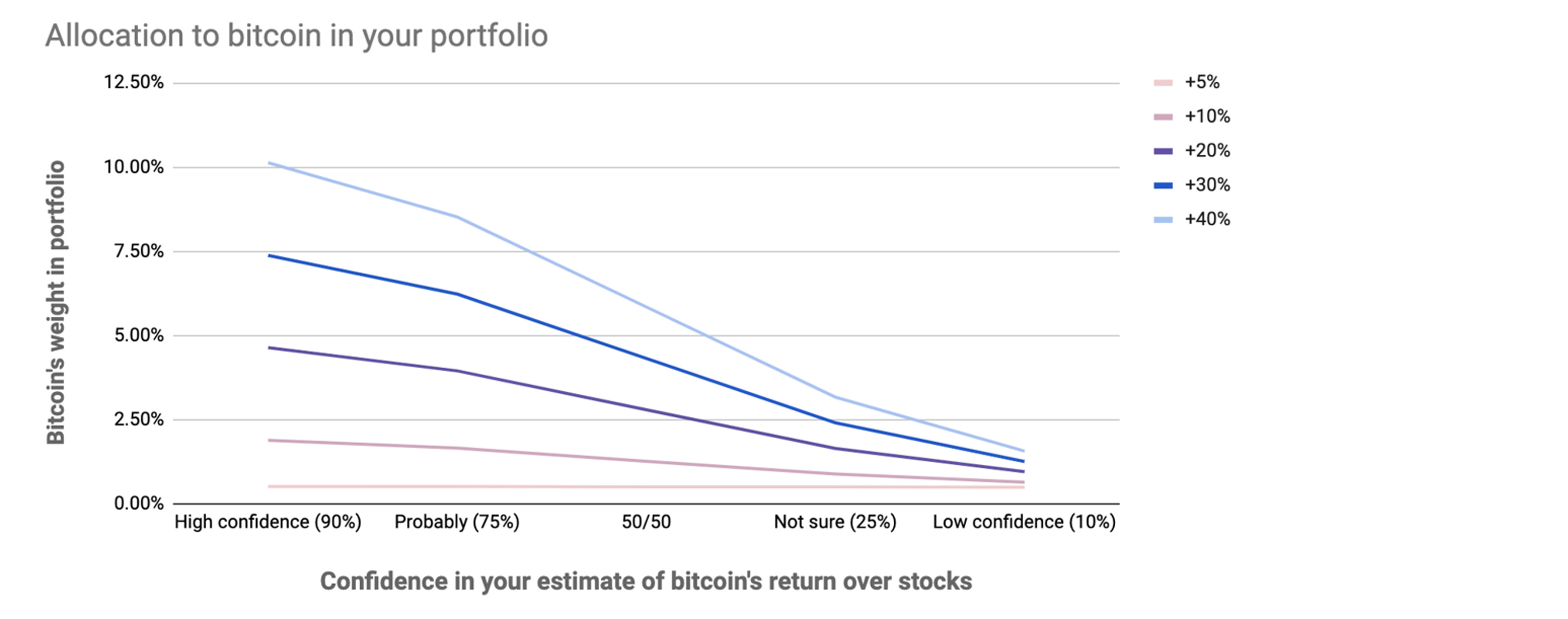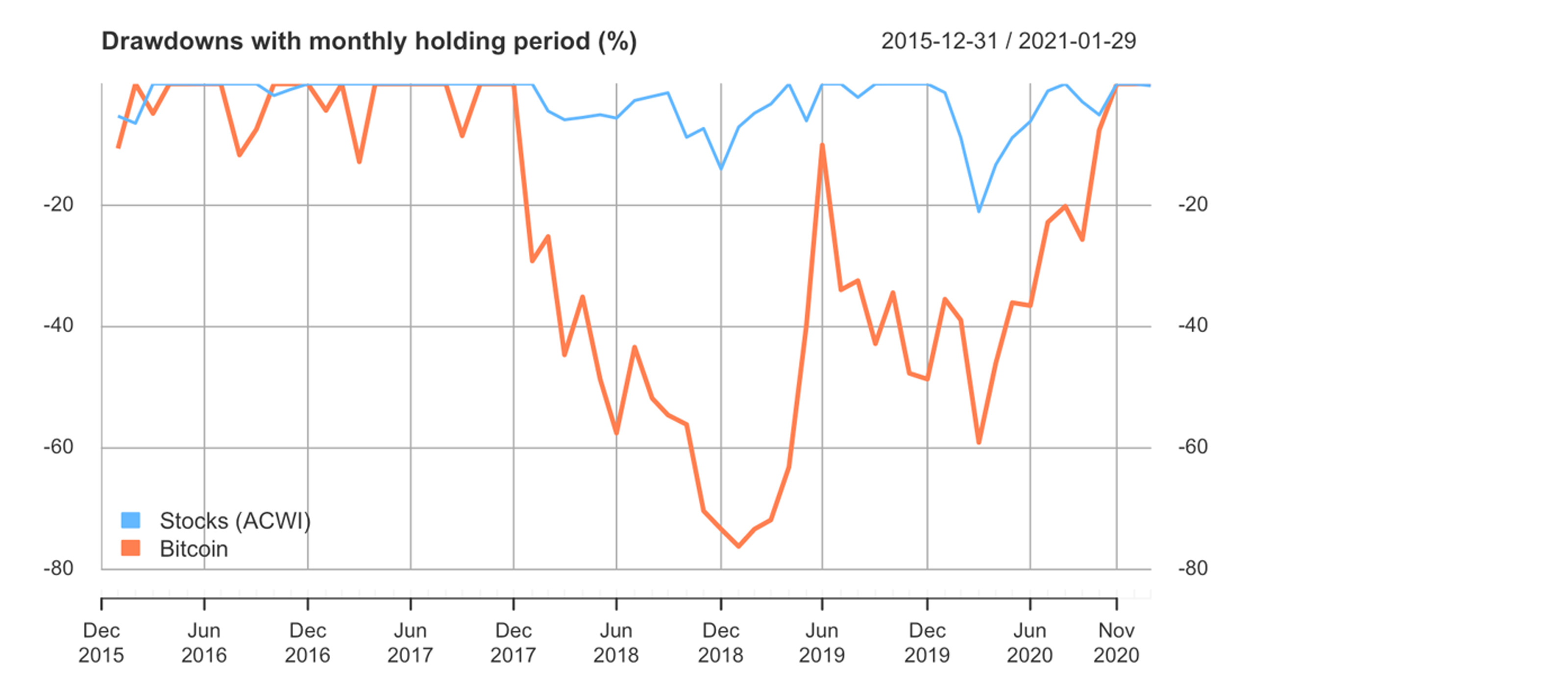How Much Bitcoin Should I Own? A Mathematical Answer
Bitcoin and other cryptocurrencies hold a certain cutting-edge allure for some investors. If you’re curious about adding bitcoin to your portfolio, here’s a formula to help steer your decision.


Many of us have followed the dramatic rises and precipitous falls of bitcoin, and cryptocurrencies in general, over the past few years. Some may have written them off entirely after 80% declines in 2018, only to see them roar back into investors’ collective consciousness in 2020. Certainly sentiment has shifted over a short two years — more institutional investors are taking a hard look at crypto, and previous naysayers have softened their views.
This all leads to one question: How much cryptocurrency should I own?
Math to the rescue
It goes without saying that this is a hard question to answer. But we can borrow a page from modern quantitative finance to help us arrive at a potential answer. For years, Wall Street “quants” have used a mathematical framework to manage their portfolios called the Black-Litterman model. Yes, the “Black” here is the same one from the famous Black-Scholes options pricing formula, Fischer Black. And “Litterman” is Robert Litterman, a longtime Goldman Sachs quant.

Sign up for Kiplinger’s Free E-Newsletters
Profit and prosper with the best of expert advice on investing, taxes, retirement, personal finance and more - straight to your e-mail.
Profit and prosper with the best of expert advice - straight to your e-mail.
Without getting into too much detail, the model starts with a neutral, “equilibrium” portfolio and provides a mathematical formula for increasing your holdings based on your view of the world. What’s amazing is that it incorporates not just your estimate about how an investment might grow, but also your confidence in that estimate, and translates those inputs into a specific portfolio allocation.
Your starting point: 0.50%
The Black-Litterman model uses the global market portfolio, meaning all the asset holdings in the world, as its starting point for building a portfolio. This means that, if you don’t have any other views on what investments might perform better or worse, this is the portfolio you should consider holding.
In early 2021, the global market for stocks totaled $95 trillion and the global bonds market reached $105 trillion. The cryptocurrency market as a whole was valued at roughly $1 trillion. This means that cryptocurrency represents 0.5% of the global market portfolio.

Just as there are plenty of arguments to hold more cryptocurrency, there are also many arguments to hold less. However, from the model’s standpoint 0.5% should be your starting allocation.
Now add your views
This is where the mathematical magic comes into play. For any given growth rate in cryptocurrency (or any investment for that matter), the Black-Litterman model will return the amount you should hold in your portfolio. What’s more, you can specify your level of conviction in that assumed growth rate and the model will adjust accordingly.
In the below chart are the portfolio allocations to bitcoin derived from the Black-Litterman model. This chart can serve as a useful guideline when thinking about how much cryptocurrency you might want to hold.
How to use it: Select how much you think bitcoin will overperform stocks, from +5% to +40%. Each return expectation corresponds to a line on the chart. For example, if you think that bitcoin will outperform stocks by 20%, this corresponds to the purple line. Now, follow the line left or right based on how confident you are. If you’re at least 75% confident (a solid “probably”), the purple lines up with a 4% allocation to bitcoin.

One of the most interesting things to note is how high your return estimate needs to be and how confident you need to be in order to take a sizable position in bitcoin. For example, for the model to tell you to hold a 10% allocation you need to be highly confident that bitcoin will outperform stocks by 40% each year.
Also of note, it does not take much to drive the model’s allocation to 0% allocation, i.e., no crypto holdings. If you don’t think that there’s a 50/50 chance that bitcoin will at least slightly outperform, the model says to avoid it entirely.
How we got here
The inputs to the Black-Litterman model tell an interesting story in and of themselves. The main inputs into the model are global market caps, asset volatility and the correlation between assets.
It goes without saying that cryptocurrencies are risky. Over the last five years, bitcoin’s volatility was six times that of stocks and 30 times that of bonds. At its worst, the digital coin saw an 80% drop in value, while stocks were down 20%. Other cryptocurrencies fared even worse.

If an asset is volatile, and one is not able to diversify that volatility away, then investors will require a higher rate of return on that investment, otherwise they will choose not to invest. The fact that bitcoin is so volatile, but has such a small number of investors (relative to stocks or bonds) suggests that many investors still do not see the potential returns worth the risks. On the other hand, cryptocurrencies are at their core a new technology, and new technologies always have an adoption curve. The story here may be less about expected return versus risk and more about early adoption versus mass appeal.
The final ingredient in the model is bitcoin’s correlation with stocks and bonds. Below you can see that bitcoin has some correlation with both stocks and bonds, meaning that when stocks go up (or down), bitcoin may do so as well. The lower the correlation, the greater the diversification an asset provides to your portfolio. Bonds have a low correlation with stocks (1.5%), which makes them a good ballast against turbulent markets. Bitcoin’s correlation is higher (23.7%), meaning that it can provide some diversification benefit to a portfolio, but not to the same degree as bonds.
Correlation heatmap

While we aren’t able to tell you if bitcoin will be the next digital gold, this mathematical model can help you think about what kind of allocation to crypto might be appropriate for you and what assumptions about risk and return might be underlying it.
Profit and prosper with the best of Kiplinger's advice on investing, taxes, retirement, personal finance and much more. Delivered daily. Enter your email in the box and click Sign Me Up.

Adam Grealish serves as Head of Investments at Altruist, a fintech company on a mission to make great independent financial advice more affordable and accessible. With a career rooted in financial innovation, Adam most recently led Betterment's strategic asset allocation, fund selection, automated portfolio management, and tax strategies. In addition, he served as a vice president at Goldman Sachs, overseeing the structured corporate credit and macro credit trading strategies.
-
 The Five Social Security Blind Spots Retirees Often Miss
The Five Social Security Blind Spots Retirees Often MissUnderstand how benefits work before applying, so you don’t lose money for which you qualify.
-
 Stock Market Today: S&P 500, Nasdaq Hit New Highs After Vietnam Trade Deal
Stock Market Today: S&P 500, Nasdaq Hit New Highs After Vietnam Trade DealAhead of a key July 9 tariff deadline, President Trump said the U.S. has reached a trade deal with Vietnam.
-
 Social Security's First Beneficiary Lived to Be 100: Will You?
Social Security's First Beneficiary Lived to Be 100: Will You?Ida May Fuller, Social Security's first beneficiary, retired in 1939 and died in 1975. Today, we should all be planning for a retirement that's as long as Ida's.
-
 An Investment Strategist Demystifies Direct Indexing: Is It for You?
An Investment Strategist Demystifies Direct Indexing: Is It for You?You've heard of mutual funds and ETFs, but direct indexing may be a new concept ... one that could offer greater flexibility and possible tax savings.
-
 Q2 2025 Post-Mortem: Rebound, Risks and Generational Shifts
Q2 2025 Post-Mortem: Rebound, Risks and Generational ShiftsAs the third quarter gets underway, here are some takeaways from the market's second-quarter performance to consider as you make investment decisions.
-
 Why Homeowners Should Beware of Tangled Titles
Why Homeowners Should Beware of Tangled TitlesIf you're planning to pass down property to your heirs, a 'tangled title' can complicate things. The good news is it can be avoided. Here's how.
-
 A Cautionary Tale: Why Older Adults Should Think Twice About Being Landlords
A Cautionary Tale: Why Older Adults Should Think Twice About Being LandlordsBecoming a landlord late in life can be a risky venture because of potential health issues, cognitive challenges and susceptibility to financial exploitation.
-
 Home Equity Evolution: A Fresh Approach to Funding Life's Biggest Needs
Home Equity Evolution: A Fresh Approach to Funding Life's Biggest NeedsHomeowners leverage their home equity through various strategies, such as HELOCs or reverse mortgages. A newer option: Shared equity models. How do those work, and what are the pros and cons?
-
 Eight Tips From a Financial Caddie: How to Keep Your Retirement on the Fairway
Eight Tips From a Financial Caddie: How to Keep Your Retirement on the FairwayThink of your financial adviser as a golf caddie — giving you the advice you need to nail the retirement course, avoiding financial bunkers and bogeys.
-
 Just Sold Your Business? Avoid These Five Hasty Moves
Just Sold Your Business? Avoid These Five Hasty MovesIf you've exited your business, financial advice is likely to be flooding in from all quarters. But wait until the dust settles before making any big moves.